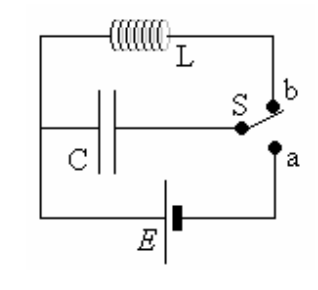
 Imagine a simple circuit which
contains an (ideal) inductance, a capacitor and a source of emf
which can be switched into or out of the circuit.
Imagine a simple circuit which
contains an (ideal) inductance, a capacitor and a source of emf
which can be switched into or out of the circuit.First we charge the capacitor by moving the switch to connect a and b. On switching the switch to exclude the battery, now consider the LC circuit. Applying the loop theorem we obtain,
but i = -dq/dt, since the charge on the capacitor is decreasing. Therefore,
 with m the
particle mass, k the spring constant and x the
displacement. In fact there is a one-to-one correspondence
between the behavior of electromagnetic oscillations in circuits
and mechanical oscillating systems.
with m the
particle mass, k the spring constant and x the
displacement. In fact there is a one-to-one correspondence
between the behavior of electromagnetic oscillations in circuits
and mechanical oscillating systems.where qm and φ are constants determined by the "initial" conditions of the system.
Substituting this general solution back into the original differential equation gives,

The capacitor is being charged and discharged as the current through the inductance reverses direction.
Energy Considerations

The potential energy stored in the magnetic field of the inductance is given by,
Therefore the sum of the electric and magnetic energy is
constant, independent of time, as shown below.
In the above graphs φ = 0
"Initial" Conditions
or φ = 0, π, 2π, ... Then
so that qm = qmax.
Actually to determine qm and φ we don't necessarily need the "initial" conditions, the values of q and i at any one value of t is sufficient.
Famous Physicists at a party : Coulomb got a real charge out of the whole thing.
Dr. C. L. Davis
Physics Department
University of Louisville
email: c.l.davis@louisville.edu
